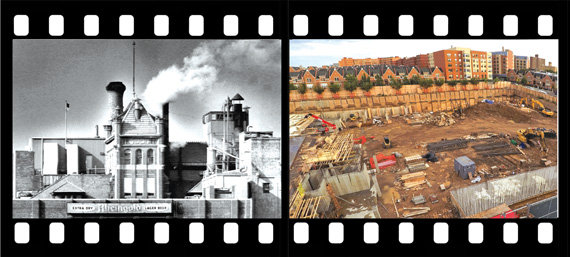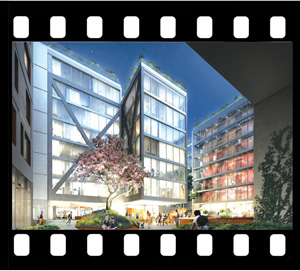Trending
Bushwick, the sequel
The long-sought redevelopment of the Rheingold Brewery site is shaping up to be a game changer

In mid-June, renderings for a Brooklyn developer’s sprawling 1 million-square-foot rental complex at the former Rheingold Brewery site were unveiled to the public. Set to be developed by Yoel Goldman [TRDataCustom] of All Year Management and designed by Gramercy-based architect firm ODA New York, the plan is modeled on a European village, showing as many as 900 apartments around interconnecting courtyards. In a wink at the site’s past, the amenities will include an urban rooftop farm with a “hop yard” for growing cultivars to be supplied to local craft brewers.
While such splashy details drew attention, a few in the media also seized on the project’s suggestive name. “The development will be named ‘Bushwick II,’ presumably because the first version of Bushwick was so popular they couldn’t resist making a sequel, this time with twice the gentrification,” Gothamist cheekily noted. Over the past decade, the neighborhood has gone from an area dotted with bodegas, tenements and vacant factories to a cultural phenomenon that’s routinely name-checked by celebrities.
A source close to the developer recently insisted that Bushwick II was an internal, unofficial name.
But the damage was already done. The sentiment of a Bushwick reboot has stuck, and perhaps fairly so. Goldman’s project is the larger of two developments on the 6.4-acre site. Last year, Simon Dushinsky of Rabsky Group released his own proposal for a project, also designed by ODA: a nearly 400,000-square-foot, 500-unit rental building on Montieth Street. Neither has a stake in the other’s project, but together they are developing the largest new residential development the neighborhood has ever seen.
At a projected total cost of at least $400 million, the two Rheingold projects will bring at least 1,300 apartments, significantly upping the development ante in the still mostly low-income area.
Citi Habitats’ David Maundrell likened the Rheingold redevelopment to those that transformed North Williamsburg from an artsy enclave into a Soho-esque destination. “This will put more of a stamp on the area — its own campus, its own world,” he said.
Unlikely developers
For Dushinsky and Goldman, both of whom are members of the insular Hasidic community in South Williamsburg, Rheingold represents their most ambitious, sophisticated endeavor to date and advances the two in the ranks of the growing number of Hasidic developers who shun the spotlight but are increasingly tackling high-profile projects geared toward millennials.
“They have chosen a personal life that is somewhat culturally removed,” said ODA’s founder Eran Chen, who described both men as “progressive” and hands-on. “They want to cater to a culture that’s not their own.”
Both developers declined to comment for this story.
Dushinsky, who develops a mix of rentals for the masses and condos geared for the Orthodox community, has focused on North Williamsburg in recent years. His projects there include two rental buildings, the 113-unit Driggs on North 9th Street and the 188-unit Leonard Pointe on Leonard Street.
Goldman, meanwhile, specializes in multifamily trades. During the 2000s, he acquired and rehabbed roughly 40 small walk-ups in Bushwick.
 His company, All Year, has roughly 2 million square feet in the pipeline, while Rabsky has more than 600,000 square feet actively under development, according to TRData.
His company, All Year, has roughly 2 million square feet in the pipeline, while Rabsky has more than 600,000 square feet actively under development, according to TRData.
Both work without partners, and they have financed their projects largely with their own money, according to sources.
In the words of TerraCRG’s Ofer Cohen, “They have built empires without fueling projects with institutional equity.”
Ownership change
The Rheingold project did not come about overnight. Two longtime real estate investors, Robert Wolf’s Read Property Group and Joseph Tabak’s Princeton Holdings, spent years amassing all the parcels for an undisclosed price. In December 2013, the investors secured approval for a rezoning that would allow for a 10-building, 977-unit rental complex with a 30 percent affordable component.
Read and Princeton always kept the option open to sell, no matter how far they advanced the plans. Their project was fully designed by, among others, S9 Architecture, a firm formerly affiliated with Perkins Eastman, which designed the Brooklyn Navy Yard’s Dock 72. The developers were “working through the finishes,” sources said, just before switching gears and opting to sell.
Sources said the firm didn’t sell out of distress. As the market was heating up, Tabak was said to have actively pushed for the partnership to sell, and both parties ultimately agreed it was best. “They did really well, having added tremendous amount of value through the [city zoning] process,” Cohen said, referring to Read and Princeton.
From 2014 to 2016, the partners sold the various parcels to Dushinsky and Goldman in a series of off-market deals that totaled $193.7 million: Dushinsky’s Rabsky acquired 10 Montieth Street for $53 million, and Goldman’s All Year snapped up 123 Melrose Street and 28 Stanwix Street for $68.5 million and $72.2 million, respectively, records show.
Together, Rabsky and All Year own only part of the entire site. Property records show Read continues to own a few parcels, including a 304,000-square-foot warehouse at 930 Flushing Avenue.
Sizing up the market
The decision by Rheingold’s original investors to sell inevitably raises the question of whether land prices in Brooklyn have peaked. January’s expiration of the 421a program for rental development put a damper on development-site deals, which fell 44 percent year-over year, according to a TerraCRG report on the first half of the year. And although Brooklyn real estate has seen soaring price growth, there are signs that the market could be cooling, particularly in North Brooklyn. A StreetEasy analysis in March projected that median sales prices in Northwest Brooklyn would dip by almost 2 percent over the next 12 months.

A rendering of All Year Management’s 900-unit rental complex
Another looming concern is how the 18-month L train shutdown, scheduled to start in January 2019, could impact Bushwick’s growing appeal. “I’m not sure if Bushwick is ready for it or they’ll make the rents,” said a local developer, who spoke on the condition of anonymity.
And although work on the site has already begun, neither developer has secured construction financing. The climate for securing construction loans in New York has tightened considerably in recent months with regard to not only luxury condos and office towers but also new multifamily projects. In terms of acquisition financing, Rabsky received $50 million from Bank Leumi, while All Year secured $70 million from Madison Realty Capital, sources said.
Dushinsky, for one, has not been as active in Bushwick as he has been in other parts of the borough. Nevertheless, Cohen dismissed the notion that he would have difficulty borrowing. “Dushinsky has the acquisition history, balance sheet and track record,” he said. “Twenty banks aren’t running after him, but I’d be shocked to see that he can’t get financing.”
He added: “Two years ago, institutional investors did not want to look at Bushwick, and now the area is being chased by institutional capital as the next North Williamsburg.”
A source close to Dushinsky said, “There’s always concern when getting into a new territory which hasn’t been tested yet. But Simon feels confident with the numbers they got for the property and the numbers for construction, and thinks he’ll be able to cover it.”
Bushwick investors and brokers are optimistic that the market will rebound in the next three years. Therefore, the projects could escape some of the market pitfalls if the timing is right. Average rents in Bushwick have seen a slight uptick, with a studio renting for $1,943 per month and a two-bedroom for $2,452 per month, according to an MNS monthly report in June. The average rent overall in the neighborhood climbed by 5.4 percent year-over-year. Inventory levels grew by 15.8 percent month-over-month in June, data showed.
Both projects will have 20 percent of the apartments reserved as affordable. The rest will be market-rate units. In June 2015, shortly after filing plans for 10 Montieth, Rabsky came under fire from community groups that accused the firm of trying to back out of its affordable housing agreement under the deal Read made. “Our main issue is none of the community benefits of the rezoning happened,” said Scott Short, assistant executive director for the nonprofit the Ridgewood Bushwick Senior Citizens Council. “We’re uncertain if the new developers will honor that. We haven’t gotten a straight answer.”
Rabsky denied the claims, arguing it has every intention of upholding the agreement. Sources close to both of the developers said that 10 percent of the 30 percent affordable housing mandate was fulfilled by giving a site to the nonprofit Churches United for Fair Housing to develop senior housing, and that they plan to adhere to the remaining 20 percent requirement.
Still, rent prices at the two projects have not yet been revealed. Sources close to both developers said the apartments will ask at least $50 to $55 per square foot in rent on average. Another source familiar with leasing in the area said he predicts market-rate rents will range from $1,900 for a studio to $5,000 for a three- or four-bedroom unit.
In general, there is a dearth of projects exceeding 200 apartments in East Brooklyn. Half a mile from the site, there is a 127-unit luxury rental at 1209 DeKalb Avenue that Read Property Group developed and sold for $58 million in 2014 just before leasing was set to begin. Rents there range from $1,775 for a studio to $3,300 for a three-bedroom.
Timing will most certainly be a factor. Construction began in January, and both projects are set to be completed by early 2018, according to Chen. Cohen said that Rheingold’s units will come to the market just after the current pipeline boom slows down, allowing for an easier lease-up. “A lot of inventory is coming to market in the next 12 months, but not as much in the next 24 to 36 months, so you’ll see a second wave,” he said.
Finally, there’s the too-big-to-fail argument — that a project of Rheingold’s magnitude can withstand the market’s ebbs and flows.
As Gabriel Saffioti of Constellation Real Estate Advisors, a Williamsburg-based commercial brokerage, said, “A project that big, you can make your own cycle.”




